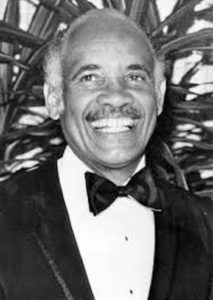
Dr. George Simkins Jr.
*Dr. George Simkins Jr. was born on this date in 1924. He was a Black dentist, community leader, and civil rights activist.
Simkins was born in Greensboro, North Carolina, the first child of George C. Simkins Sr., a dentist, and Guyrene Tyson Simkins, an educator. He grew up in sports, was a natural athlete, and was even a nationally-ranked badminton player. Simkins attended Dudley High School in Greensboro before matriculating into Herzl Junior College in Chicago and then Talladega College, from which he graduated. He earned his dentistry degree from Meharry School of Dentistry in 1948 and completed his rotating internship at Jersey City Medical Center.
Upon returning to Greensboro, Simkins opened a private dentistry practice and joined the Guilford County Health Department, becoming the first Black employed there. Beginning in 1955, Simkins used the courts and local referenda to compel the desegregation of recreational facilities, schools, and hospitals and end discrimination in the delivery of public housing, banking services, and city services. In October 1956, while the initial trespass case was still active, Dr. Simkins filed suit in the U.S. District Court for the Middle District of North Carolina against the City of Greensboro for racial discrimination in maintaining a public golf course for white citizens only. Simkins et al. v. Greensboro was filed by Dr. Simkins as head of the local chapter of the NAACP, and he was joined by nine others, including the five golfers who had joined him in December 1955. The case was immediately appealed to the Fourth Circuit Court of Appeals, which affirmed the District Court's ruling and ordered the city to discontinue operating the course on a segregated basis.
In the early 1960s, only nine North Carolina hospitals existed for African Americans; most were overcrowded and offered inadequate healthcare. According to historian Karen Thomas, "Most hospitals in North Carolina and throughout the South did not accept black patients on an equal basis and did not allow black physicians to admit patients or train as interns." Even though most North Carolina hospitals were privately operated, some accepted state and federal funds, which implicated possible government discrimination. Moses H. Cone Memorial Hospital was one of two Greensboro hospitals that had received state and federal funds via the 1946 Hill-Burton Hospital Survey and Construction Act. After the Cone and Long Hospitals had denied his patient, he discovered that the same facilities had been built with federal funding. This fact opened a pathway for a possible legal remedy. According to Karen Kruse Thomas, the Simkins v. Cone (1963) "decision marked the first time that federal courts applied the Equal Protection clause of the Fourteenth Amendment to prohibit racial discrimination by a private entity".
A year later, Congress passed the Civil Rights Act of 1964, officially prohibiting private discrimination in public places. Between 1963 and 2001, there were over 260 references to Simkins in other legal decisions, more than any other case involving hospital racial discrimination. In the spring of 1964, Simkins helped start a movement by organizing the picketing of Wachovia Bank for job discrimination. Picketing began on April 28, 1964, and ended just forty-eight hours later with the hiring of two black tellers. George Simkins Jr. died on November 21, 2001.